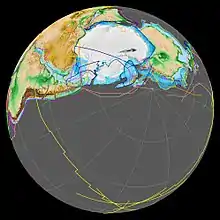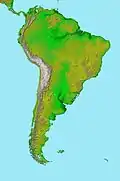Terra Australis Orogen
The Terra Australis Orogen (TAO) was the oceanic southern margin of Gondwana which stretched from South America to Eastern Australia and encompassed South Africa, West Antarctica, New Zealand and Victoria Land in East Antarctica.[1]

Origins
Terra Australis Orogen formed in the Neoproterozoic and Paleozoic. The decline of orogenic activity in the late Paleozoic is related to the assembly of the supercontinent Pangea. The orogeny did not end by a continental collision and was succeeded by the Gondwanide orogeny.[2] c. 18,000 km (11,000 mi) long and up to 1,600 km (990 mi) wide,[3] the TAO was one of the longest and longest-lived active continental margin in the history of Earth, lasting from the beginning of its formation during the break-up of the Neoproterozoic supercontinent Rodinia.[1]
The TAO evolved through a series of extensional back-arcs separated by compressional events when the subducting oceanic plate got stuck in Gondwana's margin.[4]
As Gondwana was amalgamated in the Early Palaeozoic during the so-called Pan-African orogenies the TAO propagated along the southern (modern coordinates) Proto-Pacific/Iapetus margin of the supercontinent. The TAO ended c. 300 to 230 Ma with the Gondwanide orogeny. This and younger orogens covers most of the outboard margin of the TAO, and, likewise, the inboard margin is almost entirely covered by younger deposits and ice but remains exposed in Australia along the Torrens Hinge Line or Delamarian orogeny. One end of the TAO was a series of terranes (Avalonia–Carolina–Cadomia) which were rifted off the western margin of Gondwana and added to Laurentia in the Late Palaeozoic, while its other end probably reached past Australia into New Guinea.[3]
In 1937 Alexander du Toit proposed the Samfrau Orogeny as an evidence for Gondwana. His concept includes the orogenies of West Gondwana and orogenies that are now considered separate events but excludes those of East Gondwana.[3]
See also
References
- Notes
- Pankhurst & Vaughan 2009, Abstract
- Cawood 2005
- Cawood 2005, Definition and Tectonic Framework, pp. 4–6
- Aitchison & Buckman 2012, Introduction, p. 2
- Sources
- Aitchison, J. C.; Buckman, S. (2012). "Accordion vs. quantum tectonics: Insights into continental growth processes from the Paleozoic of eastern Gondwana" (PDF). Gondwana Research. 22 (2): 674–680. doi:10.1016/j.gr.2012.05.013. Retrieved 8 October 2017.
- Cawood, Peter A. (2005). "Terra Australis Orogen: Rodinia breakup and development of the Pacific and Iapetus margins of Gondwana during the Neoproterozoic and Paleozoic". Earth-Science Reviews. 69: 249–279. doi:10.1016/j.earscirev.2004.09.001.
- Pankhurst, R. J.; Vaughan, A. P. (2009). "The tectonic context of the Early Palaeozoic southern margin of Gondwana" (PDF). Geological Society, London, Special Publications. 325 (1): 171–176. doi:10.1144/SP325.9. Retrieved 14 October 2017.
